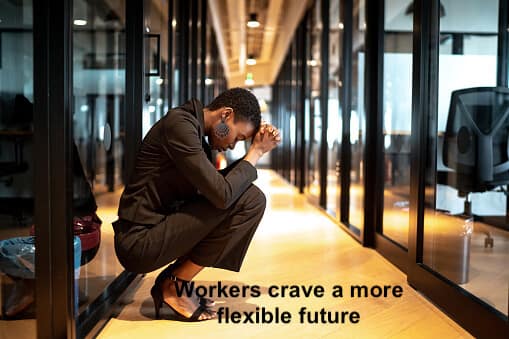The global pandemic brought disruptions to the usual patterns of working for most. How can HR help to create new ways of working that benefit both employees and employers? How can employees achieve a good work-life balance and feel strongly connected to their teams?
In this short read, produced in partnership with Winningtemp, we explore what the future of post-pandemic working life may look like, in discussion with HR and employee wellness talking heads. Find why transparency, two-way communication and kindness are set to play a bigger role than ever in future workplaces across all industries.
All is quiet in the haematology department of one highly respected London hospital. The space where Costa Coffee used to be is now deserted. Seats which were previously occupied by waiting patients are now partially cordoned off. And the main footfall is from masked and harassed-looking nurses, bustling between fraught appointments.
The patients treated in this department have blood conditions, like cancer, which leave their immune systems compromised. The nurses entrusted with their care face the difficult and lonely task of semi-isolating, while taking twice-weekly at-home Covid tests and continuing to cope with the ongoing fallout of staff shortages. And while the situation may have become considerably worse since the pandemic began, research published in the Journal of Nursing Management suggests that workplace loneliness can be an occupational hazard for the profession.
In truth, Covid-19 has exacerbated many existing workplace problems. In healthcare, this means jobs which have always been tough are now putting people’s mental health at serious risk. One study in The BMJ found that, in a survey of over 700 intensive-care and anaesthetic staff, nearly half have reported symptoms consistent with PTSD (post-traumatic stress disorder), severe depression or anxiety.
In transport and logistics – another area where workers have been employed at the coalface through the pandemic – the numbers of stressed, overworked, and burnt-out employees are scaling new heights. Similarly, in the food sector, a Food Industry Executive survey has shown endemic problems around employee safety and productivity have risen steeply.
Office workers are also feeling the strain. A study commissioned by LinkedIn, in partnership with the Mental Health Foundation, suggests that individuals now working from home are increasing their workload by an average of 28 extra hours each month. This is on top of additional tasks such as childcare, housework and cooking more meals.
Workers crave a more flexible future
Despite the pressures and downsides of new ways of working, Slack’s Future Forum index of 4,700 remote workers found that most did not want to return to their previous work life. The lack of commute, and the time saved by not attending physical meetings, meant that 72% wanted a “hybrid remote-office model moving forward”.
Liz Forte, who is a health and wellness director within the food and logistics sectors, where many workplaces have stayed open, describes how “experience has moved up the agenda”. She says her role at Compass Group B&I, which runs leading workplace restaurant provider Eurest and 14forty, has meant she has seen a change in some behaviours, mixed with some “unchanging needs”.
“Eurest has been serving food in workplaces throughout the pandemic, as many workers still need to go to an established place of business,” she notes. “We serve many businesses in sectors like manufacturing and logistics, whose employees have adapted to more subtle changes [than a mass move to homeworking].”
Even in these industries, great swathes of the workplace are remote, though, so “welcoming people back into workplaces will be a delicate task,” Liz says. “We must ensure people feel safe and secure and support the need for flexibility and different working patterns, including staged returns.”
A more employee-centric future workplace?
Whatever the industry or pattern of working it requires, people are key to any business. Liz Sebag-Montefiore, director and co-founder of 10Eighty, a strengths-based HR consultancy, says the future for organisations is “around making things employee-centric”. For her, this means giving employees freedom with accountability.
She also advises employers to place a strong focus on wellbeing: “Look at what, in your workplace environment, can be adjusted to reduce stress. So, you might consider flexible working hours, regular check-ins, negotiated downtime – and consider how to best use a variety of communication channels to engage with staff.”
Pierre Lindmark, CEO at Winningtemp – an organisation which provides tools to help leaders understand their employees’ needs, concerns and motivation – seconds this approach. “Employee engagement and wellbeing are key to organisational and employee success,” he says.
“Empower and engage employees by actively involving them in decision making. Take work-life balance seriously and allow for flexibility. In this, you will build an environment of effectiveness. [You must] understand your employees’ needs, build trust, and always communicate with them openly and with transparency,” he adds.
Interestingly, the Journal of Nursing Management research, conducted before the pandemic, corroborated this approach. It concluded that the problem of workplace loneliness amongst nurses could be tackled by managers sharing more information and communicating more frequently with their staff. It also highlighted that loneliness was reduced when staff trusted their leaders and found their work more meaningful.
In some ways, the pandemic has forced and catalysed changes that were gradually taking place anyway, by hastening a move to a kinder, more people-focused, workplace. And the value of this cannot be overestimated – because whether people are caring for the sick, running businesses or talking to customers, happier workers simply perform better.


